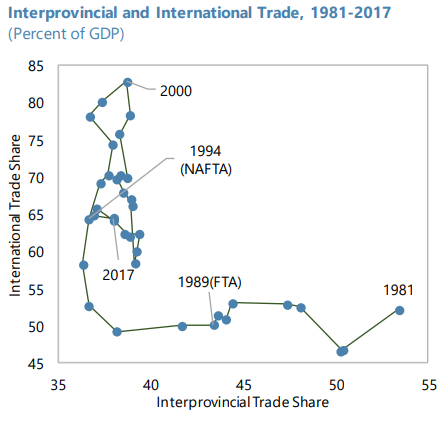If there is one finding of near unanimous consensus among economists, it is that free trade increases productivity and boosts growth. The flip side is that tariffs, quotas, and other trade barriers generally reduce welfare.
By how much? A recent study by the International Monetary Fund suggests Canada—on account of trade impediments between the provinces—is foregoing a 4 percent increase in GDP per capita. On Prince Edward Island, the loss could be as high as 16 percent.
What boggles the mind is that this harm is self-inflicted: these are trade restrictions within Canada, not with the outside world. Despite boasting trade agreements with 45 countries, Canadians who live in different provinces cannot trade freely among themselves.
Notwithstanding marginal improvements in recent years, Canada has been stuck with forgone internal trade due to misguided provincial protectionism. The country has arrived at a point at which there are foreign companies with better access to portions of Canada than Canadian companies themselves.
While Canadians can cite the 1995 Agreement on Internal Trade (AIT) and the 2017 Canadian Free Trade Agreement (CFTA) as improvements, their broad exemptions defy the free-trade moniker. The fact they were needed at all is a telling indication of the prevailing policy approach toward internal commerce.
An example of excessive restrictions Canadian companies face is the coexistence of multiple provincial regulations that prevent trucks from efficiently transporting goods nationwide. Ranging from the sizes and weights of vehicles allowed on highways to the types of tires, trucks crossing across provincial lines go from legal to illegal. This cripples the Canadian industry’s productivity as it adds unnecessary costs to transportation. There is no wonder why some companies prefer to import goods from the United States, where trucks only need one license.
Consider the status of alcohol. Even in the 21st century, Canadians cannot freely order beer online produced in another province. While the federal government is finally abolishing the requirement that all alcohol crossing provincial boundaries go through a federal liquor authority, each legislature needs to change its own laws before this absurd roadblock goes in the dustbin of history. Only a handful of provinces have done so, and even then the amount must not exceed “personal use.”
The evolution of Canada’s interprovincial integration is nothing short of disappointing. In the 1980s, each sum total of interprovincial trade and international trade (exports and imports combined) equally represented 55 percent of GDP. While the latter boomed to 80 percent following the 1994 North American Free Trade Agreement, the former dropped to less than 40 percent in the 1990s and has remained there through 2017. Geography and distance play an important role, but dairy quotas, trucking requirements, occupational licensing, and other barriers prevent commerce from unlocking its full potential.

The good news is the federal officials have the power to enforce the constitution, which guarantees free trade among provinces. Do they have the political will?
The 1867 Constitution Act states the flow of goods must be free across all provinces. It also states the federal government can block any provincial regulation that interferes with internal commerce. Nevertheless, the Supreme Court has ruled on multiple occasions that, while provinces cannot impose tariffs, they can demand licenses, issue fines, and otherwise regulate domestic trade under the guise of federalism. Wrongly, the court believes protectionism has only an “incidental” effect on trade.
Regions historically marginalized from interprovincial commerce—such as Nova Scotia, Prince Edward Island, Yukon, and Newfoundland and Labrador—have been reducing their non-geographical trade barriers over the years. The AIT, signed in 1995, was the first major reduction in interprovincial trade barriers in a wide variety of areas, from the commerce of goods and services to investments and labor mobility. However, its scope remained limited because only a narrow list of products were liberalized.
Recognizing the AIT was not enough, all 10 provinces, the three territories, and the federal government signed a new agreement in 2017, the Canadian Free Trade Agreement (CFTA).
The CFTA took the opposite approach: it liberalized all products and services except for a long list, which takes up more than one-third of the 353-page agreement. Nevertheless, it helped put pressure on protectionists and enhanced transparency. Besides, the agreement strengthened penalties for non-compliant provinces while fully harmonizing rules with international treaties.
Despite these improvements, the average non-geographical barriers remain high. Alberta, British Columbia, and Ontario are relatively open to trade, while Manitoba, Prince Edward Island, Nova Scotia, Yukon, and Newfoundland and Labrador have high barriers.
As Canada prepares to finalize the revamped United States-Mexico-Canada Agreement (USMCA), she cannot demand access to foreign markets with a straight face while keeping trade arbitrarily restrained at home.



